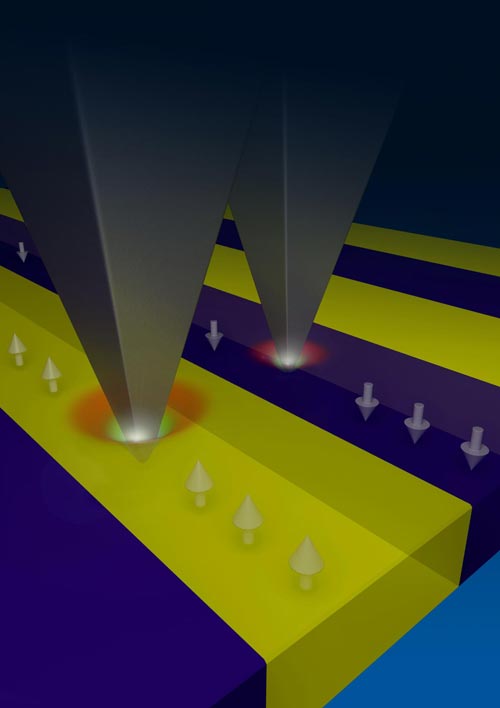Strange but true: Turning a material upside down can sometimes make it softer

This is an artistic representation of the new material. Credit: ICN2
PhD student Kumara Cordero-Edwards is the lead author of this work, carried out in collaboration with researchers from the Autonomous University of Barcelona (UAB). Highlighted in the journal's frontispiece, the article outlines how the indentation toughness of polar crystals can be manipulated in such a way that they become easier or harder to dent from a given direction.
This is the result of the interaction between the localised flexoelectric polarisation caused by the mechanical stress gradient of the indentation, on the one hand, and the piezoelectric polarisation inherent in polar crystals, on the other. If the two polarisations run parallel, overall polarisation is going to be very strong.
This carries a higher energy cost, which makes the act of indentation itself more difficult. But if we turn the material over, the flexoelectric effect of the knock will be acting in the opposite direction to the spontaneous piezoelectric effect, making total polarisation weaker and indentation correspondingly easier.
But the observations of our researchers did not end there. In the case of a particular subset of piezoelectric materials, ferroelectrics, it is not even necessary to physically turn the material upside down; we can simply apply an external voltage to flip its polar axis.
These effects were observed not only for forceful indentations and/or perforations, but also for the gentler, non-destructive pressures delivered by the tip of an atomic force microscope.
Aside from potential applications in smart coatings with switchable toughness, these effects could one day be used as a means of reading ferroelectric memories by touch alone.
Media Contact
All latest news from the category: Materials Sciences
Materials management deals with the research, development, manufacturing and processing of raw and industrial materials. Key aspects here are biological and medical issues, which play an increasingly important role in this field.
innovations-report offers in-depth articles related to the development and application of materials and the structure and properties of new materials.
Newest articles

High-energy-density aqueous battery based on halogen multi-electron transfer
Traditional non-aqueous lithium-ion batteries have a high energy density, but their safety is compromised due to the flammable organic electrolytes they utilize. Aqueous batteries use water as the solvent for…

First-ever combined heart pump and pig kidney transplant
…gives new hope to patient with terminal illness. Surgeons at NYU Langone Health performed the first-ever combined mechanical heart pump and gene-edited pig kidney transplant surgery in a 54-year-old woman…

Biophysics: Testing how well biomarkers work
LMU researchers have developed a method to determine how reliably target proteins can be labeled using super-resolution fluorescence microscopy. Modern microscopy techniques make it possible to examine the inner workings…





















